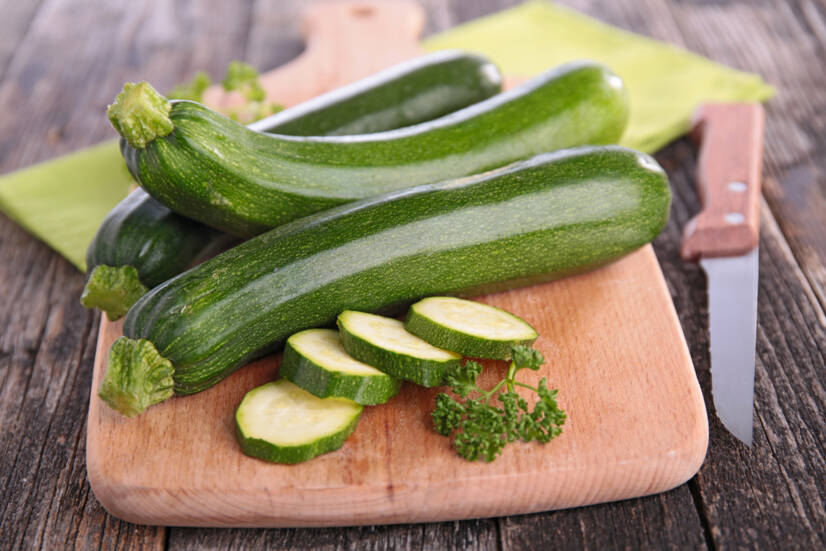Zucchini, what are its health benefits? (Vitamins and uses)

Courgette is a delicious and tasty vegetable that can be used to add variety to your diet. It can be used to make salads, soups, main dishes, spreads and even pies. You can also easily grow it at home.
Characteristics
This vegetable is also very popular because of its low-calorie composition and its many nutrients. It contains no fat at all.
It is also very popular for slimming diets due to its high water content, which reaches up to 90 %. Thanks to the water, it has a cleansing and antibacterial effect on the body.
In addition to water, it also contains vitamins A, B, C, E and K. Of the minerals, potassium, magnesium, phosphorus, manganese, selenium, sodium, calcium, fibre, zinc and iron.
It also contains beneficial substances such as carotenes, riboflavin and folic acid.
It is a vegetable that can easily be grown on a balcony. It grows on low bushes with large green leaves.
It has a beautiful colour at flowering time and apart from its usefulness, it will also be a decoration in your garden. The flower is large and yellow, in some cases it can be light yellow or orange.
Depending on the variety, the fruit can be harvested from mid-June to October. From the outside it resembles a cucumber, with a smooth, glossy green surface.
Inside, it resembles a pumpkin, but there is a seed in the middle which can be eaten without fear.
The zucchini's origins date back to Italy, as revealed by its name, zucchini, which comes from the Italian word for pumpkin, zucca.
Internal use
Zucchini is a very popular ingredient among creative cooks and chefs. It has little distinctive flavour and aroma, so it is easy to combine and can be used in a wide variety of dishes.
It makes dishes healthier and more interesting. It is not recommended to discard the skin when preparing dishes as it contains a large amount of vitamin C.
Courgettes can be used, for example, in spreads, soups, whether meat or vegetable, and main dishes. They can be prepared like meat, i.e. fried, grilled or stewed with other vegetables in their juices.
It can also be used in side dishes such as salad or courgette mash.
It can also be used for desserts, whether cakes or even pies.
Apart from being a great helper in the kitchen, it is also very beneficial for our organism.
It is particularly helpful for digestive problems. It promotes peristalsis, i.e. the activity of the intestines, very well. At the same time, it also cleanses and does not burden the kidneys, which also has a beneficial effect on the entire digestive tract.
Thanks to its composition, it can rid the body of excess water and salt.
In addition to getting rid of excess water, it also boosts metabolism, thereby reducing fatigue and boosting energy.
In this case, it also helps to satiate during diets through fiber and also lowers cholesterol thanks to potassium.
The combination of fiber and potassium also works on blood circulation health, which is good for blood pressure and a healthy heart.
Due to its ability to cleanse the body and rid the body of pollutants, it will promote rejuvenation of the body and reduce inflammation in the body.
External use
For external use, zucchini is also very useful. It is beneficial for the skin and especially the eye area.
An excellent trick can be used by those who peel the zucchini after all, if they are bothered by the skin in the food. This can be used as an eye mask. Thanks to its composition, after 30 minutes of application, puffiness and circles under the eyes should be reduced. It is best to repeat it several times a day.
It can also be made into a full body mask. Just grate the zucchini, mix it with olive oil and sour cream and the mask is ready. Such a mask is best for sunburned skin, but also to fight wrinkles or dry skin.
Harvesting and storage
The harvesting of courgettes depends on the individual species, but it is common for them to ripen gradually and thus be available in the garden from June to October.
You can tell when they are ripe by the fact that the fruit is slightly softer than the others. It can also be indicated by a knocking sound, as in the case of melon.
The ripeness of the courgette also depends on its size. Young courgettes of around 25 cm are best.
If you harvest it regularly, you will create fertile soil for more to grow.
You should also leave at least 3 cm of stems when harvesting. This will keep them fresh for longer and prevent them from spoiling.
Storage is easy. Just leave it in a cool, dry and ventilated room. Some people also recommend waxing the stem, it should last even longer.
The key is not to wash the zucchini after harvesting and to clean it thoroughly of soil.
Growing courgettes
Courgettes need warm, moist soil in which they thrive best. In temperate regions it is recommended to grow them in greenhouses.
Some varieties bear fruit in good conditions as early as one and a half months after sowing.
Seeds should be planted well apart as the plant needs plenty of space. Spacing should be at least 70 cm to 1 m long.
It is recommended to water the soil, especially to prevent leaf scorch or stem rot.
On rainy days, the fruit should also be protected from direct contact with wet soil, for example by laying it on wood wool, straw or sawdust.
Fruits could begin to rot and mould.










